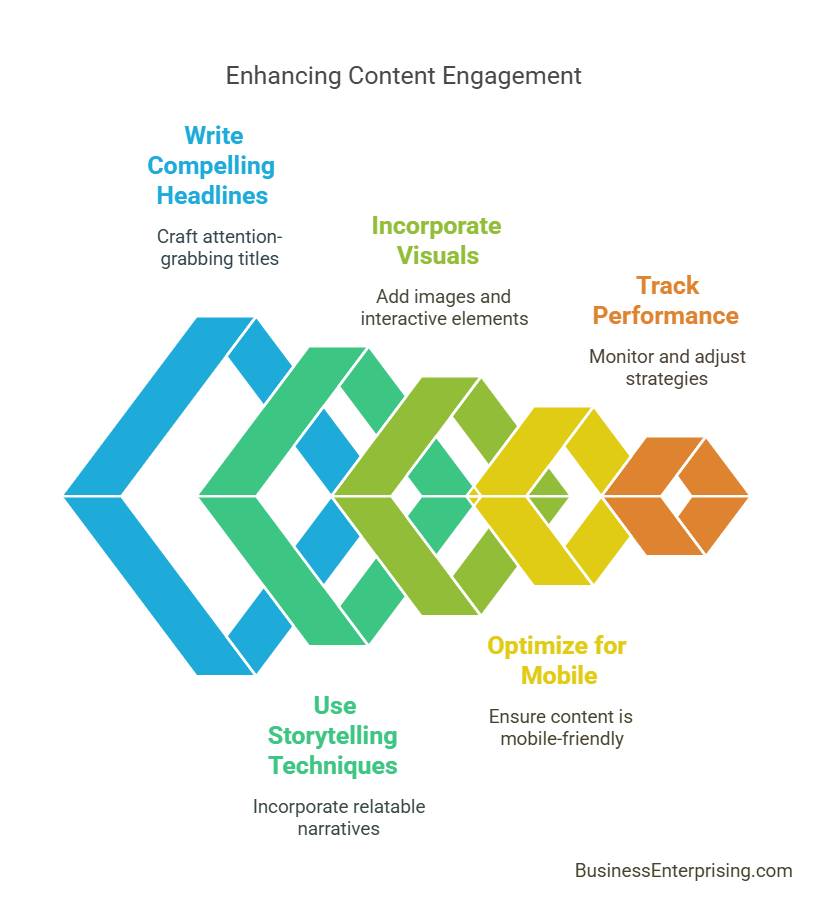
Creating compelling content starts with strong headlines and clear structure. However, breaking up text with visuals and interactive features makes information easier to digest. Additionally, encouraging comments and social sharing keeps readers involved and builds a sense of community. These strategies help turn passive visitors into active participants.
Engaging content requires a balance of readability, relevance, and interaction. Therefore, refining your approach based on audience behavior improves performance over time. By focusing on clarity and user experience, you create content that informs, entertains, and encourages ongoing engagement.
Understanding Your Target Audience’s Needs and Preferences
Understanding your target audience’s needs and preferences is essential for creating relevant and valuable content. Audience research methods like surveys, analytics, and personas help you gather insights into their behaviors and interests. Additionally, reviewing website traffic and engagement metrics provides real-time data on what content resonates most. By using these tools, you can identify patterns and tailor your content accordingly.
However, knowing how to create engaging content requires more than just data. Aligning your message with audience pain points ensures that your content remains relevant and useful. For example, addressing common challenges or frequently asked questions helps build trust and credibility. Additionally, using language that reflects your audience’s tone and style improves connection and engagement.
Content that speaks directly to audience needs encourages interaction and loyalty. Therefore, continuously refining your approach based on feedback and analytics is important. By staying responsive to changes in preferences, you keep your content fresh and valuable. This strategy strengthens audience relationships and enhances the overall impact of your messaging.
Crafting Attention-Grabbing Headlines and Introductions
Crafting attention-grabbing headlines and introductions is essential for capturing your audience’s interest. A strong headline sets the tone and encourages clicks. However, vague or generic headlines often fail to attract attention. Using clear, specific language helps readers understand the value of your content immediately. Additionally, posing a question or highlighting a problem can spark curiosity and make them want to learn more.
Your introduction should hook readers within the first few sentences. Starting with a bold statement or surprising fact creates immediate engagement. Additionally, addressing a common frustration or challenge helps connect with your audience’s needs. By making your opening relatable, you encourage readers to keep scrolling.
Knowing how to create engaging content begins with a compelling start. Therefore, keep your headlines and introductions concise and impactful. Avoid unnecessary details in the beginning, and focus on delivering value quickly. By capturing interest early, you increase the chances of keeping your audience engaged throughout your content.
Using Storytelling Techniques to Build Connection
Using storytelling techniques helps you build a strong connection with your audience. Narratives make content more relatable and memorable, encouraging deeper engagement. However, simply presenting facts often fails to create an emotional response. By framing your message within a story, you give readers a reason to care. Additionally, using real-life examples makes abstract concepts easier to understand and apply.
Your brand voice also plays a key role in storytelling. A consistent and authentic tone makes your content feel more personal and trustworthy. Additionally, aligning your messaging with your audience’s experiences strengthens their connection to your brand. Whether sharing a customer success story or explaining a challenge you overcame, storytelling makes your content feel genuine.
Knowing how to create engaging content requires more than just delivering information. Therefore, weaving stories into your content encourages readers to stay invested. By making your audience feel seen and understood, you build trust and long-term loyalty. This approach keeps your content meaningful and impactful.
Incorporating Visual and Interactive Elements
Incorporating visual and interactive elements makes your content more engaging and easier to digest. Large blocks of text can feel overwhelming, causing readers to lose interest. However, adding images, videos, and infographics breaks up content and makes key points more memorable. Additionally, visuals help explain complex topics in a way that’s quick to understand.
Interactive elements encourage deeper engagement by inviting users to participate. Quizzes, polls, and clickable graphics keep readers involved rather than just consuming information. Additionally, interactive tools can provide personalized insights, making the content more valuable. By including these features, you create a dynamic experience that holds attention longer.
Knowing how to create engaging content means thinking beyond just words. Therefore, using a mix of text, visuals, and interactive elements keeps your audience interested. By making your content visually appealing and interactive, you increase user engagement and encourage longer visits. This approach helps create a more enjoyable and informative experience for your readers.
Optimizing Readability and Scannability
Optimizing readability and scannability makes your content easier to digest and more appealing to readers. Long paragraphs can feel overwhelming, causing visitors to lose interest. However, breaking up text into shorter sections improves readability and keeps attention focused. Additionally, using subheadings helps readers quickly find the information they need without scrolling aimlessly.
Formatting plays a key role in user experience. Bullet points and numbered lists highlight important details, making content easier to skim. Additionally, spacing between paragraphs improves clarity, especially on mobile devices. Readers often scan content before deciding to engage, so structuring information clearly increases retention. By prioritizing readability, you create a better experience for your audience.
Knowing how to create engaging content means making it accessible to all users. Therefore, using clear fonts, simple language, and structured formatting keeps content easy to follow. By improving readability, you encourage longer visits, reduce bounce rates, and improve overall engagement. A well-structured layout makes your message more effective and keeps readers coming back.
Encouraging User Interaction and Feedback
Encouraging user interaction and feedback transforms passive readers into engaged participants. Adding clear calls-to-action invites visitors to share thoughts, ask questions, or take the next step. However, generic prompts often go unnoticed. Phrasing calls-to-action as direct, engaging questions makes them more effective. Additionally, placing them at natural points in your content increases the likelihood of a response.
Comments sections provide another way to boost engagement. Readers appreciate spaces where they can express opinions, ask for clarification, or discuss topics further. However, keeping discussions active requires ongoing interaction. Responding to comments encourages more participation and builds a sense of community. Additionally, moderating discussions helps maintain a positive and constructive environment.
Social sharing prompts make it easy for readers to spread your content. Adding visible share buttons encourages users to post articles on social media. Additionally, prompting readers to share personal insights related to your topic increases engagement. Knowing how to create engaging content means fostering conversation and inviting interaction. By prioritizing user participation, you build stronger relationships and create a more dynamic experience.
Conclusion
Knowing how to create engaging content requires a thoughtful approach and a focus on audience needs. However, engagement goes beyond simply providing information. Encouraging interaction, using visuals, and optimizing readability all contribute to a better user experience. Additionally, storytelling and clear formatting keep readers interested and make content easier to consume.
By incorporating calls-to-action and inviting feedback, you turn passive readers into active participants. However, maintaining engagement requires consistency. Regularly updating content and refining your approach based on audience behavior strengthens long-term connections. Additionally, tracking performance helps identify what works and what needs improvement.
Creating engaging content is an ongoing process. Therefore, staying adaptable and listening to your audience ensures lasting success. By prioritizing quality, clarity, and interaction, you make your content more impactful and valuable.



